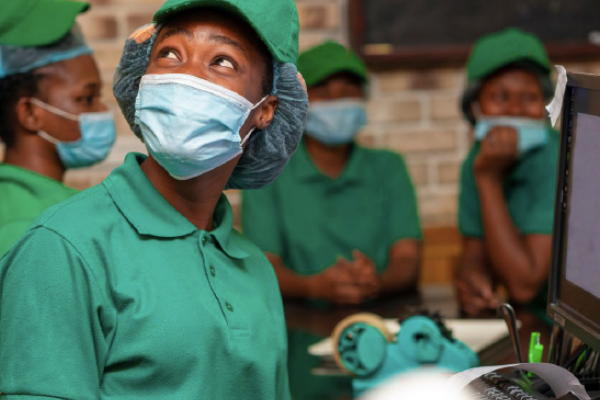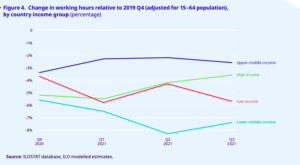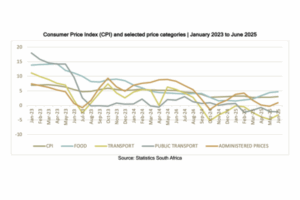The impact of Covid-19 on labour markets shows a stalled global recovery and significant disparities between advanced and developing economies, according to a new report published by the International Labour Organisation (ILO).
Globally, the working hours in 2021 will be 4.3% below pre-pandemic levels (the fourth quarter of 2019), the equivalent of 125 million full-time jobs, the ILO has projected in the eighth edition of the ILO Monitor: COVID-19 and the world of work. In June, the ILO projected global hours worked at 3.5% or 100 million full-time jobs.
Without concrete financial and technical support, the current trajectory of labour markets is of a stalled recovery, coupled with downside risks and a “great divergence” between developed and developing economies.
“Unequal vaccine distribution and fiscal capacities are driving these trends and both need to be addressed urgently,” says Guy Ryder, Director-General of ILO.
In June the ILO adopted the Global Call to Action for a human-centred COVID-19 recovery roadmap, which commits countries to ensure that their economic and social recovery from the crisis is fully inclusive, sustainable and resilient.
“It is time to implement this roadmap, which is fully aligned with and supports the United Nation’s Common Agenda and Global Accelerator for Jobs and Social Protection,” says Ryder.
The ILO Monitor reports on the impacts of Covid-19 on the world of work and suggests policy options to mitigate these impacts. The latest issue features the six key messages.
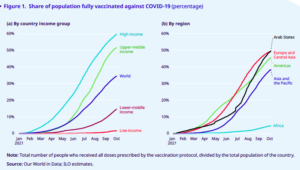
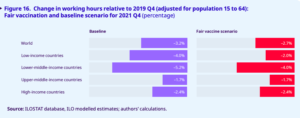
The six key messages
Return to workplace and vaccination: Slow progress in low- and middle-income countries
Progress in vaccination is a critical factor for labour market recovery. The share of fully vaccinated people globally was 34.5% in early October, but with considerable differences between high-income countries (59.8%) and low-income countries (1.6%). Higher vaccination rates are associated with less stringent workplace restrictions. Overall, specific areas and sectors have been targeted for workplace closures.
Hours worked: A stalled global recovery
Global working hours in 2021 are estimated to remain significantly below the level attained in the last quarter of 2019. Working hours in high- and upper-middle-income countries tended to recover in 2021, while lower-middle and low-income countries continued to suffer large losses. From a regional perspective, Africa, the Americas and the Arab States showed declines of 5.6, 5.4 and 6.5 per cent respectively. Global labour productivity (output per working hour) grew in 2020 by more than twice the long-term average. In 2021, global labour productivity growth has slowed down significantly, with negative growth in low- and lower-middle‑income countries. As a result, the “productivity gap” between developing and advanced economies has grown.In 2020, the average worker in a high-income country produced 17.5 times more output per hour than the average worker in a low-income country. This gap has increased to 18.0 in 2021, the biggest difference since 2005.
Employment, unemployment and inactivity: An unequal picture
The latest global estimates and country-level data confirm the unequal employment impact of the COVID‑19 crisis in 2020, as well as the fragile and often diverging recovery trends over the first half of 2021. The number of people employed and participating in the labour force hasn’t recovered fully in many countries. Young people, especially young women, are most affected.Stimulus: Indispensable, but developing countries don’t have the same options
Fiscal stimulus packages continue to be a key tool for supporting recovery. In developing countries (particularly low-income countries), the fiscal stimulus gap is still largely unaddressed. Estimates show that, on average, an increase in fiscal stimulus of 1% of annual GDP would have increased annual working hours by 0.3 percentage points by the first quarter of 2021 relative to the last quarter of 2019.Vaccination: Faster roll-outs are crucial for recovery
Higher vaccination rates, like fiscal stimulus packages, are associated with a stronger and faster labour market recovery. Estimates show that for every 14 persons fully vaccinated in the second quarter of 2021, one full-time equivalent job was added to the global labour market. This implies that the slow roll-out of vaccination in developing countries is affecting the recovery of the labour market. It is also increasing the disparities between countries.Prospects for the rest of 2021: Weak and uncertain
Prospects for labour market recovery for the rest of 2021 remain weak and uncertain. Vaccination will continue to be a key factor in shaping the eventual labour market outcome for 2021. In a “fair vaccination” scenario for the fourth quarter of 2021, low-income and lower-middle-income countries could reduce their working-hour losses considerably, effectively increasing the hours worked by 2 and 1.2 percentage points, respectively. A “fair vaccination” scenario assumes an equitable distribution of vaccines globally.


